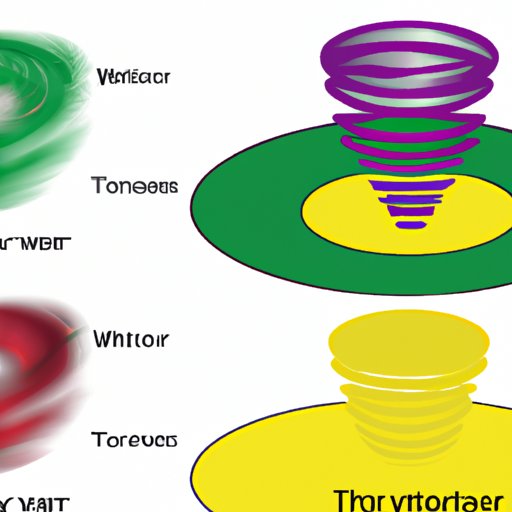Introduction
A vortex is defined as “a mass of whirling fluid or air, especially a whirlpool or whirlwind” (Merriam-Webster Dictionary, 2021). This article will explore the science of vortexes, looking at how they form, the physics behind them, and the impact they have on nature. It will also examine examples of vortexes that can be found in everyday life.
Exploring the Science of Vortexes
Vortex phenomena are not just isolated to whirlpools in water or dust devils in deserts. They can occur anywhere where there is a flow of energy or substance, such as in the atmosphere, oceans, or even inside a vacuum tube. Vortexes are the result of swirling fluids or gases, and can range from small eddies to large storms. In fact, some of the most powerful storms on Earth are the result of complex vortex formations.
How Do Vortexes Form?
Vortexes form when a fluid or gas is set into motion. This can be due to external forces, such as wind or gravity, or due to internal forces, such as pressure or temperature gradients. As the fluid or gas moves, it creates a rotating pattern that results in a vortex. The strength of the vortex depends on the speed and direction of the flow, as well as the size of the container the fluid or gas is contained in.

Investigating the Physics of Vortexes
The science of vortexes is complex and fascinating. There are several different types of vortexes, each with its own unique characteristics. Some of the most common types of vortexes include tornadoes, dust devils, hurricanes, waterspouts, and smoke rings. Each type of vortex has its own distinct properties, such as size, shape, and speed.
The physics behind vortexes is equally complex. Vortexes are governed by the laws of fluid dynamics, which are used to describe the behavior of liquids and gases. These laws allow scientists to better understand the formation, structure, and movement of vortexes. By studying these laws, scientists can develop models to predict how a vortex will behave in certain conditions.

Vortexes: A Closer Look at the Phenomenon
Vortexes play an important role in nature. They can cause destruction, such as in the case of tornadoes or hurricanes, but they can also be beneficial. For example, vortexes can help move nutrients and oxygen through bodies of water, aiding aquatic life. They can also be used as a source of energy, such as in the case of wind turbines.
Vortexes can also be found in everyday life. For instance, smoke rings are often seen at parties or during performances. Other examples include the spinning blades of a ceiling fan, the water coming out of a showerhead, or the swirls of cream in your coffee.
Conclusion
In conclusion, vortexes are fascinating phenomena that can be found in nature and everyday life. They are formed when a fluid or gas is set into motion, and the strength of the vortex depends on the speed and direction of the flow. There are several different types of vortexes, each with its own unique characteristics, and they are governed by the laws of fluid dynamics. Finally, vortexes play an important role in nature, both destructive and beneficial, and provide many examples of how they can be found in everyday life.
(Note: Is this article not meeting your expectations? Do you have knowledge or insights to share? Unlock new opportunities and expand your reach by joining our authors team. Click Registration to join us and share your expertise with our readers.)
